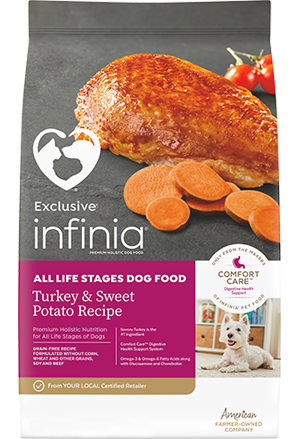
DogFoodAdvisor is reader supported See how
All reviews are 100% impartial but if you buy using links on this page, we may earn a referral fee.
Our Verdict
Infinia dry product range is made up of three recipes with ratings varying from 3.5 to 4 stars. The average rating of the whole range is 4 stars.
The table below shows each recipe in this range including our rating and the AAFCO nutrient profile: Growth (puppy), Maintenance (adult), All Life Stages, Supplemental or Unspecified.
| Product line | Rating | AAFCO |
|---|---|---|
| Infinia Turkey and Sweet Potato All Life Stages | 4 | A |
| Infinia ZenFood Salmon & Sweet Potato Adult | 3.5 | M |
| Infinia Chicken and Brown Rice All Life Stages | 4 | A |
Recipe and Label Analysis
Infinia Turkey and Sweet Potato All Life Stages was selected to represent the other products in the line for detailed recipe and nutrient analysis.
Infinia Turkey and Sweet Potato All Life Stages
Estimated Dry Matter Nutrient Content
Protein
Fat
CarbsCarbohydrates
Turkey, turkey meal (source of glucosamine and chondroitin sulfate), chicken meal, sweet potatoes, potatoes, peas, dried egg product, canola oil (preserved with mixed tocopherols), pea protein, tomato pomace, natural flavor, salmon oil (preserved with mixed tocopherols) (source of EPA and DHA), salt, sodium tripolyphosphate, dried yeast, vitamins (vitamin E supplement, d-calcium pantothenate, vitamin A supplement, niacin supplement, riboflavin supplement, thiamine mononitrate, pyridoxine hydrochloride, vitamin D3 supplement, menadione sodium bisulfite complex, folic acid, biotin, vitamin B12 supplement), calcium carbonate, choline chloride, minerals (zinc proteinate, zinc oxide, ferrous sulfate, manganous oxide, manganese proteinate, copper sulfate, sodium selenite, copper proteinate, calcium iodate, cobalt carbonate), dried chicory root, citric acid (preservative), preserved with mixed tocopherols, dried cranberries, dried blueberries, dried apples, dried kelp, dried carrots, dried spinach, tomato flakes, dried milk protein, parsley flakes, Yucca schidigera extract, l-carnitine, taurine, yeast culture, dried Enterococcus faecium fermentation product, dried Lactobacillus acidophilus fermentation product, dried Aspergillus niger fermentation extract, dried Trichoderma longibrachiatum fermentation extract, dried Bacillus subtilis fermentation extract, rosemary extract
Fiber (estimated dry matter content) = 4.5%
Red denotes any controversial items
| Estimated Nutrient Content | |||
|---|---|---|---|
| Method | Protein | Fat | Carbs |
| Guaranteed Analysis | 32% | 16% | NA |
| Dry Matter Basis | 36% | 18% | 39% |
| Calorie Weighted Basis | 30% | 37% | 33% |
Ingredients Analysis
The first ingredient in this dog food is turkey. Although it is a quality item, raw turkey contains up to 73% water. After cooking, most of that moisture is lost, reducing the meat content to just a fraction of its original weight.
After processing, this item would probably account for a smaller part of the total content of the finished product.
The second ingredient is turkey meal. Turkey meal is considered a meat concentrate and contains nearly 300% more protein than fresh turkey.
The third ingredient is chicken meal, another protein-rich meat concentrate.
The fourth ingredient includes sweet potato. Sweet potatoes are a gluten-free source of complex carbohydrates in dog food. They are naturally rich in dietary fiber and beta carotene.
The fifth ingredient lists potato, another gluten-free source of digestible carbohydrates. Yet with the exception of perhaps their caloric content, potatoes are of only modest nutritional value to a dog.
The sixth item includes peas. Peas are a quality source of carbohydrates. And like all legumes, they’re rich in natural fiber.
However, peas contain about 25% protein, a factor that must be considered when judging the meat content of this dog food.
The seventh ingredient is dried egg product, a dehydrated form of shell-free eggs. Quality can vary significantly. Lower grade egg product can even come from commercial hatcheries — from eggs that have failed to hatch.
In any case, eggs are easy to digest and have an exceptionally high biological value.
The eighth ingredient is canola oil. Unfortunately, canola can be a controversial item. That’s because it can sometimes (but not always) be derived from genetically modified rapeseed.
Yet others cite the fact that canola oil can be a significant source of essential omega-3 fatty acids.
In any case, plant-based oils like canola are less biologically available to a dog than fish oil as a source of quality omega-3 fats.
The ninth ingredient is pea protein, what remains of a pea after removing the starchy part of the vegetable.
Even though it contains over 80% protein, this ingredient would be expected to have a lower biological value than meat.
And less costly plant-based products like this can notably boost the total protein reported on the label — a factor that must be considered when judging the meat content of this dog food.
From here, the list goes on to include a number of other items.
But to be realistic, ingredients located this far down the list (other than nutritional supplements) are not likely to affect the overall rating of this product.
With seven notable exceptions…
First, we find tomato pomace. Tomato pomace is a controversial ingredient, a by-product remaining after processing tomatoes into juice, soup and ketchup.
Many praise tomato pomace for its high fiber and nutrient content, while others scorn it as an inexpensive pet food filler.
Just the same, there’s probably not enough tomato pomace here to make much of a difference.
Next, we find dried yeast, which can be a controversial item. Dried yeast contains about 45% protein and is rich in other healthy nutrients.
Fans believe yeast repels fleas and supports the immune system.
Critics argue yeast ingredients can be linked to allergies. This may be true, but (like all allergies) only if your particular dog is allergic to the yeast itself.
What’s more, a vocal minority insists yeast can increase the risk of developing the life-threatening condition known as bloat. However, this is something we’ve not been able to scientifically verify.
In any case, unless your dog is specifically allergic to it, we feel yeast should be considered a nutritious addition.
In addition, this food contains chelated minerals, minerals that have been chemically attached to protein. This makes them easier to absorb. Chelated minerals are usually found in better dog foods.
This recipe also contains sodium selenite, a controversial form of the mineral selenium. Sodium selenite appears to be nutritionally inferior to the more natural source of selenium found in selenium yeast.
We also note the use of taurine, an important amino acid associated with the healthy function of heart muscle. Although taurine is not typically considered essential in canines, some dogs have been shown to be deficient in this critical nutrient.
Since taurine deficiency appears to be more common in pets consuming grain-free diets, we view its presence in this recipe as a positive addition.
Next, chicory root is rich in inulin, a starch-like compound made up of repeating units of carbohydrates and found in certain roots and tubers.
Not only is inulin a natural source of soluble dietary fiber, it’s also a prebiotic used to promote the growth of healthy bacteria in a dog’s digestive tract.
And lastly, this food includes menadione, a controversial form of vitamin K linked to liver toxicity, allergies and the abnormal break-down of red blood cells.
Since vitamin K isn’t required by AAFCO in its nutrient profiles, we question the use of this item in any canine recipe.
Nutrient Analysis
Based on its ingredients alone, Infinia Dog Food looks like an above-average dry product.
The dashboard displays a dry matter protein reading of 36%, a fat level of 18% and estimated carbohydrates of about 39%.
As a group, the brand features an average protein content of 30% and a mean fat level of 17%. Together, these figures suggest a carbohydrate content of 46% for the overall product line.
And a fat-to-protein ratio of about 57%.
Near-average protein. Near-average fat. And below-average carbs when compared to a typical dry dog food.
Even when you consider the protein-boosting effect of the peas, pea protein and dried yeast, this looks like the profile of a kibble containing a significant amount of meat.
Infinia Dog Food Recall History
The following automated list (if present) includes all dog food recalls related to Infinia through March 2025.
No recalls noted.
You can view a complete list of all dog food recalls since 2009 here.
Our Rating of Infinia Dog Food
Infinia includes both grain-inclusive and grain-free dry dog foods that use a significant amount of named meat meals as their dominant source of animal protein, thus earning the brand 4 stars.
Highly recommended.
However, those concerned about the presence of menadione in this recipe may wish to ignore our rating and look elsewhere for a different product. Or consider using diet rotation to reduce the risks associated with feeding the same dog food… continuously, for a lifetime.
Compare Infinia Dog Food
How does Infinia compare with The Dog Food Advisor's most recommended brands?
A Final Word
The Dog Food Advisor does not accept money, gifts, samples or other incentives in exchange for special consideration in preparing our reviews.
However, we do receive a referral fee from online retailers (like Chewy or Amazon) and from sellers of perishable pet food when readers click over to their websites from ours. This helps cover the cost of operation of our free blog. Thanks for your support.
For more information, please visit our Disclaimer and Disclosure page.








